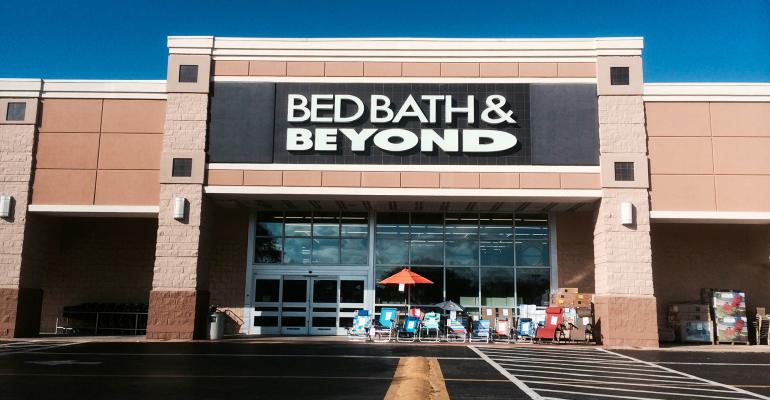(Bloomberg) -- Bed Bath & Beyond Inc. called off a proposed debt exchange and said it might not be able to continue as a going concern, bringing another US retail chain to the precipice of bankruptcy.
The Union, New Jersey-based company said in a filing Thursday that it’s taking steps to improve its cash position, but that recurring losses and negative cash flow in the nine months ended Nov. 26 leave “substantial doubt” that it can stay in business. The company said it’s pursuing options such as restructuring debt, selling assets or filing for bankruptcy-court protection, but added “these measures may not be successful.”
The home-goods retailer also pulled the outstanding debt exchange offer that would have given creditors the chance to swap unsecured bonds for a lower face value amount of new secured obligations. Moving forward with the plan, which aimed to trim the company’s overall debt load, could have complicated a potential bankruptcy.
Some suppliers had begun to halt shipments to the retailer in recent months, concerned about the company’s outlook. That aggravated its already tenuous financial situation, accelerating a downward spiral that has been nearly a decade in the making. Bed Bath & Beyond, which for decades has been a mainstay of malls and shopping centers around the US, was plagued by years of management missteps and a dysfunctional corporate culture that left it ill-equipped to compete against Amazon.com Inc. and other online retail juggernauts.
Following the announcements, Bed Bath & Beyond’s bonds fell to new lows. Its 2024 notes traded down to 21 cents on the dollar, from around 23 cents Wednesday, and its 2034 notes fell to 8 cents on the dollar, from around 10 cents, according to Trace.
Bed Bath & Beyond warned on Thursday that it expects to report third-quarter revenue of $1.259 billion — below the $1.404 billion analysts had estimated and a steep decline from the $1.878 billion the company reported a year ago. Losses are also mounting, with Bed Bath & Beyond expecting a net loss of about $386 million for the three months that ended Nov. 26 — about 40% larger than the loss reported a year earlier.
The drop in third-quarter sales and the widening losses indicate that the holiday shopping season was worse for Bed Bath & Beyond than executives at the company had anticipated.
“My best guess is that they will go into bankruptcy,” said Lauren Greenwood, president of kitchen storage and organization company YouCopia, which has sold merchandise to Bed Bath & Beyond in the past. She expects the retailer to close additional stores and emerge from a potential bankruptcy filing as a smaller company.
“I just think there is so much value in the Bed Bath brand,” Greenwood said. At the end of August, the company already said it was closing about 150 poorly-performing stores and cutting 20% of jobs across its corporate and supply-chain operations.
Other suppliers said that Bed Bath & Beyond is more likely to try to restructure its debts rather than liquidate because the company is well known across the US — an advantage that gives it an edge over other struggling retailers. The company needs to harness that name-recognition to improve its e-commerce operations, which are lackluster compared to competitors, and encourage shoppers to buy online and pick up in store, for example, to boost foot traffic, some suppliers said.
“Many students made their first major purchase at Bed Bath when they were going to college and many individuals signed up for the wedding registry when they were getting married,” said Steve Greenspon, chairperson of the International Housewares Association trade group. “I believe they have an ongoing position in retail,” he added.
Private-Label Shift
During the pandemic, Bed Bath & Beyond increased its offering of private-label products — a change that deterred many loyal customers who were looking for their favorite brands. Earlier this year, as part of a broader turnaround plan, Bed Bath & Beyond said it was pivoting back to selling well-known national brands such as as Oxo, Ninja and SodaStream.
“Despite more productive merchandise plans and improved execution, our financial performance was negatively impacted by inventory constraints,” Bed Bath & Beyond Chief Executive Officer Sue Gove said in a statement. But, she added, “we have already leveraged the liquidity gained from the holiday season to immediately pursue higher in-stock levels with support from our key vendors. We have seen trends improve when in-stock levels have increased.”
The company said it will report its third-quarter results on Jan. 10, which is delayed compared to previous years. Executives will hold a conference call with analysts at 8:15 a.m. New York time that day.
Shares of Bed Bath & Beyond fell 23% at 12:44 p.m. New York time. The stock had already lost more than 83% of its value since the end of 2021.
--With assistance from Eliza Ronalds-Hannon.
© 2023 Bloomberg L.P.




